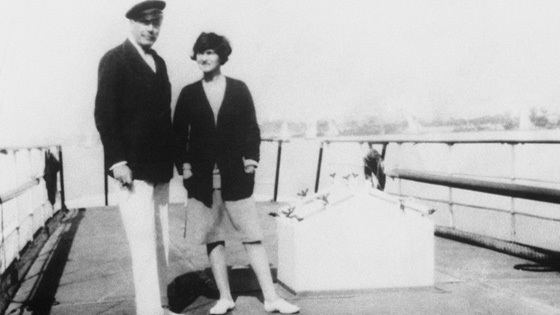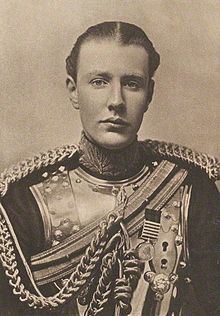Name Hugh 2nd | Children Lady Mary Grosvenor | |
 | ||
Full Name Hugh Richard Arthur Grosvenor Born 19 March 1879 ( 1879-03-19 ) Died July 19, 1953, Achfary, United Kingdom Parents Victor Grosvenor, conte di Grosvenor Spouse Constance Lewes, Violet Cripps, Baroness Parmoor, Loelia Lindsay, Anne Grosvenor, Duchess of Westminster | ||
Hugh Richard Arthur Grosvenor, 2nd Duke of Westminster, (familiarly "Bendor") (19 March 1879 – 19 July 1953) was a British landowner and one of the wealthiest men in the world.
Contents
- Nickname BendOr
- Estate
- Early life and character
- Military service
- Chanel
- Political ideology
- Marriages and issue
- Death and succession
- Styles of address
- References

He was the son of Victor Grosvenor, Earl Grosvenor, son of the 1st Duke of Westminster, and Lady Sibell Lumley, the daughter of the 9th Earl of Scarborough.

Nickname "Bend'Or"

From his childhood and during his adult life he was known within family circles as "Bendor", which was also the name of the racehorse Bend Or owned by his grandfather the first Duke, which won the Epsom Derby in 1880, the year following his grandson's birth. The name is a jovial reference to the ancient lost and much lamented former armorials of the family: Azure, a bend or, which were awarded to the Scrope family in the famous case of 1389 heard before the Court of Chivalry, known as Scrope v Grosvenor. His wife Loelia wrote in her memoirs: "Of course everybody, even his parents and sisters, would normally have addressed the baby as "Belgrave" so they may have thought that any nickname was preferable. At all events it stuck, and my husband's friends never called him anything but Bendor or Benny".
Estate

His ancestral country estate in Cheshire, the 54-bedroom Eaton Hall consisted of 11,000 acres (45 km2) of parkland, gardens and stables. The main residence had its walls hung with master works, paintings by Goya, Rubens, Raphael, Rembrandt, Hals, and Velázquez. An avid participant in the hunting life, the Duke owned lodges reserved for the sport in Scotland and France (the Château Woolsack). According to his Times obituary (21 July 1953), "he was busy up to the day of his death in great schemes of afforestation in Cheshire, in the Lake District, and in Scotland."
For sea excursions, he had his choice of two sailing vessels, “The Cutty Sark”, and a yacht, “Flying Cloud”. For ground transportation he had 17 Rolls Royce automobiles and a private train built to facilitate travel from Eaton Hall directly into London where his townhouse Grosvenor House was located. Grosvenor House was later leased to The United States for use as the American Embassy.
Early life and character
Like many of his social class whose lives were ones of privilege and leisure, the Duke occupied himself in the pursuit of pleasure. He was described as "a pure Victorian who had eyes for his shotgun, his hunters, his dogs … a man who enjoyed hiding diamonds under the pillow of his mistresses …" He did not, however, avoid military service, volunteering to fight as a front-line officer in both the Boer War and the First World War. As a nineteen year old, he briefly attended a French boarding school run by the Count de Mauny, who was rumoured to have made sexual advances towards some of its pupils. In later life the Duke was notable for being virulently opposed to such practices.
Military service
Lord Grosvenor had taken a commission with the Royal Horse Guards and was in South Africa serving in the Second Boer War, when in December 1899 he succeeded his grandfather. After a brief visit back home, he returned in February 1900 to serve with the Imperial Yeomanry, as an ADC to Lord Roberts and Lord Milner. He resigned his commission in December 1901, and was appointed Captain of the Cheshire (Earl of Chester´s) Imperial Yeomanry the following month. He subsequently invested in land in South Africa and Rhodesia.
In 1908, the Duke competed in the London Olympics as a motorboat racer for Great Britain. On 1 April 1908, he was named honorary lieutenant-colonel of the 16th Battalion, The London Regiment, a post he held until 1915.
In the First World War the Duke volunteered for front-line combat and served with distinction, showing both initiative in battle and technical skill with motor-cars. Whilst attached to the Cheshire Yeomanry he developed a prototype Rolls-Royce Armoured Car for their use. During their 1916 campaign in Egypt, as part of the Western Frontier Force under General William Peyton, the Duke (then a major) commanded the armoured cars of the regiment and took part in the destruction of a Senussi force at the Action of Agagia on 26 February 1916. On 14 March 1916, he led the armoured cars on a daring raid against superior forces that destroyed the enemy camp at Bir Asiso. Learning that the crews of HMT Moorina and HMS Tara were being held at Bir Hakeim, he led the nine armoured cars - with three armed but unarmoured cars and a further 28 cars and ambulances - on a 120-mile (190 km) dash across the desert to rescue them. Their Senussi captors attempted to run away but were gunned down by the enraged British rescuers. The prisoners attempted to stop the killings but failed. They had substisted on little more than the snails in which the region abounded, but said their captors had not been overly cruel. However, the chief jailor responsible for the snail diet, a cleric nicknamed "Holy Joe", was hanged to general approval. The Duke received the DSO for his exploits. He was subsequently promoted colonel and on 26 May 1917, he was named honorary colonel of the regiment.
Chanel
In 1925, he was introduced to Gabrielle ("Coco") Chanel after a party in Monte Carlo and pursued her. He was as extravagant with her as he was with all of his lovers. He purchased a home for Chanel in London's prestigious Mayfair district, and in 1927 gave her a parcel of land on the French Riviera at Roquebrune-Cap-Martin where Chanel built her villa, La Pausa. His romantic liaison with Chanel lasted ten years. An illustration of both Westminster’s extravagance and orchestrated technique in the courting of women has endured in the form of various apocryphal stories. He purportedly concealed a huge uncut emerald at the bottom of a crate of vegetables delivered to Chanel. Disguised as a deliveryman, Westminster appeared at Chanel’s apartment with an enormous bouquet of flowers. His ruse was only uncovered after Chanel’s assistant offered “the delivery boy” a tip.
Political ideology
In 1931, the Duke, a Conservative, exposed his brother-in-law, William Lygon, 7th Earl Beauchamp (1872–1938), as a homosexual to the King and Queen. He reportedly hoped to ruin the Liberal Party through Beauchamp. The king was horrified, supposedly saying, "I thought men like that shot themselves."
During the run-up to World War II, he supported various right-wing and anti-Semitic causes, including the Right Club. "His anti-Semitic rants were notorious," according to a biographer of Coco Chanel. In her book The Light of the Common Day, Lady Diana Cooper reminisces back to 1 September 1939. She and her husband, the prominent Conservative Duff Cooper were lunching at London's Savoy Grill with the Duke of Westminster. She recalls;
when he [the Duke of Westminster] added that Hitler knew after all that we were his best friends, he set off the powder-magazine. "I hope". Duff spat, "that by tomorrow he will know that we are his most implacable and remorseless enemies". Next day "Bendor (Duke of Westminster)", telephoning to a friend, said that if there was a war it would be entirely due to the Jews and Duff Cooper.
The Duke, known for his pro-German sympathies, was reportedly instrumental in influencing his former mistress, Coco Chanel, to use her association with Winston Churchill to broker a bilateral peace agreement between the British and the Nazis. It was in late 1943 or early 1944 that Chanel, and her then current lover, Nazi espionage agent, Baron Hans Gunther Von Dinklage, did undertake such an assignment. Code named "Operation Modellhut", it was an attempt through the British Embassy in Madrid, via Chanel, to influence Churchill, and thereby persuade the British to negotiate a separate peace with Germany. This mission as planned ultimately met with failure, as Churchill had no interest.
Marriages and issue
On 16 February 1901, the Duke married Constance Edwina (Shelagh) Cornwallis-West (1876–1970). They had three children:
On 26 November 1920, the Duke became the second husband of Violet Mary Nelson (1891–1983). They were divorced in 1926.
Westminster married Loelia Mary Ponsonby (1902–1993) on 20 February 1930. The couple were unable to have children and divorced in 1947 after several years of separation.
He married Anne (Nancy) Winifred Sullivan (1915–2003) on 7 February 1947. She outlived him by fifty years.
The Duke was known for multiple love affairs and spectacular presents. After Coco Chanel he was fascinated by the Brazilian Aimée de Heeren who was not interested in marrying him and to whom he gave significant jewellery, once part of the French Crown Jewels.
Death and succession
The Duke died of coronary thrombosis at Loch More Lodge on his Scottish estate in Sutherland in 1953, aged 74, and was buried in the churchyard of Eccleston Church near Eaton Hall, Cheshire.
His large estate attracted then-record death duties of £18m, which took between July 1953 and August 1964 to pay off to the Inland Revenue.
He left two daughters. His titles and the entailed Westminster estate passed to his cousin, William Grosvenor, and thence to the two sons of his youngest half-uncle Lord Hugh Grosvenor (killed in action 1914). The title is now held by Hugh Grosvenor, 7th Duke of Westminster.
